Terms and Conditions
Terms and Conditions for Ecommerce Stores
Most websites have a link to a Terms and Conditions agreement that users and customers agree to in order to use the site. Ecommerce stores are no different. Nearly every ecommerce store has a link to a custom Terms and Conditions agreement posted in the site footer or some other conspicuous location such as a registration or checkout page.
If you own or operate an ecommerce store, you need to have your own Terms and Conditions agreement. This helps you establish legally enforceable ground rules for the proper use of your site and it limits your legal liability in the event of product malfunction or a customer dispute.In this post, we’ll take a careful look at the recommended structure of a Terms and Conditions agreement. We also will look at some examples in use on other ecommerce sites, and help you get started with creating one for your online store.
What is a Terms and Conditions Agreement?

A Terms and Conditions agreement (also called a Terms of Service, Terms of Use, or simply Terms) is a legally binding agreement that allows you to protect your business and limit your liability. It does this by establishing your legal rights and limitations in written form.
Your Terms and Conditions agreement should lay out the rules you want your online shoppers to abide by if they want to browse your store or make purchases. Since your Terms and Conditions agreement is legally enforceable, both you and your customers can enforce the Terms established in the agreement.
A customer’s agreement with your Terms and Conditions is sometimes implied, meaning you assume the customer agrees to your Terms by virtue of browsing your site, downloading information, purchasing products and otherwise interacting with your store. This type of implied consent is called a browsewrap agreement.
However, as privacy laws evolve to become more strict, browsewrap is being phased out and more and more ecommerce stores are requiring shoppers to tick a box or click a button to actively acknowledge and accept the Terms and Conditions to comply with laws. This type of agreement is called a clickwrap agreement, meaning the user must take action to confirm their consent to the agreement. It is the preferred and recommended method to best protect you and your online store from legal liability.
As an ecommerce site owner, you can enforce your Terms by refusing to allow an online shopper to browse your site or purchase products. The customer also can enforce the Terms by filing a lawsuit.
A Terms and Conditions agreement typically is organized to cover several important sections or clauses, depending on the nature of the business. In general, a good Terms and Conditions for an ecommerce store should contain the following clauses:
- Limitations of liability
- Intellectual property/trademark protection
- Pricing and payment terms, including shipping, returns, exchanges and cancellations
- Product information
- Dispute resolution
Why Do Ecommerce Stores Need a Terms and Conditions Agreement?

If you own or operate an ecommerce store, it’s a good idea to have a Terms and Conditions agreement posted on your website, though it’s not required by law.
A good Terms and Conditions agreement allows you to legally define and enforce the rules your customers must follow to interact with and make purchases from your online store. In addition to this, the Terms and Conditions agreement also gives you a platform to limit your liability in case a product you sell is faulty, and to define what happens in the event of a customer dispute.
Here are a few reasons why it’s a good idea to have a detailed Terms of Conditions agreement posted on your ecommerce website:
- It can protect you and your business from liability
- It can clarify your online store’s checkout process
- It can protect your intellectual property and trademarks, and define acceptable use cases
- It can give a detailed account of how you intend on handling and resolving disputes
- It gives you a platform to explain your payment terms, delivery terms, product information, warranties, return/refund policy, order cancellation and so forth
If, for instance, you own or operate an ecommerce store that sells t-shirts and you don’t want your customers to copy the unique designs and messages you print on the t-shirts, you could include a statement in your Terms and Conditions that establishes this. You also could provide a detailed account of the procedure you would follow if an individual were to violate those established intellectual property rights.
Here’s an example from the UK T-Shirt Printing. The Ordering section of their Terms and Conditions agreement establishes that any designs produced by the company are part of their intellectual property and may not be used without prior written consent.
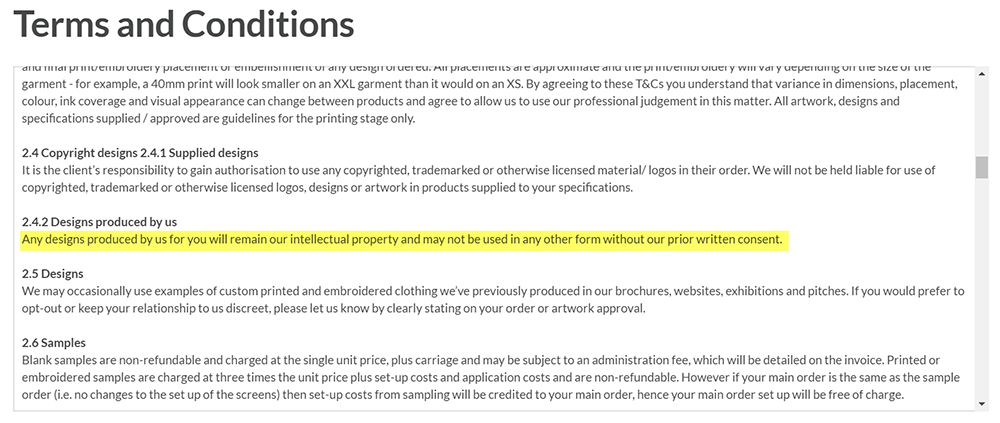
Later in the agreement, a Returns clause establishes that returns are not accepted due to the custom nature of the products.

Considerations such as these are important when creating the Terms and Conditions for your ecommerce store.
Let’s look a little more closely at the details you may want to include in your store’s Terms.
What to Include in a Terms and Conditions Agreement for Ecommerce Stores

There are a number of different clauses that you should include in your Terms and Conditions agreement to protect your ecommerce store. Let’s take a close look at four of the most essential ones.
1. Limitation of Liability
Perhaps the most important reason it’s a good idea to have a Terms and Conditions agreement for your ecommerce store is that it allows you to legally limit your liabilities and prevent customer litigation.
This clause lets your customers know that you or your business will not be held responsible in case of any liability issues. These may be related to personal injury, death, fraudulent misrepresentation, defective items or other product, service or delivery problems.
Often, the Limitation of Liability clause is written in all caps or a bold font in order to convey its importance and to draw attention to it.
Here’s a typical example, from online retailer Forever 21:

This No Liability clause establishes that Forever 21 will not be liable for how you use the website, the content posted on it, damages, theft of user information, or the inability to use the website. It also says that in case something like this happens, your sole remedy is to stop using the website. In other words, if something goes wrong, Forever 21 is not responsible for it.
Another interesting limitation established in the Forever 21 Terms of Use is a section on Product Information. This section explains that the products you see on the website are available in select stores across the United States while supplies last. It also says that in some cases, items that are on sale on the website may not be available in stores.

By establishing no liability and the limitations of product availability, Forever 21 is avoiding legal problems and costs from customer claims of faulty website functionality or false product advertising.
Etsy provides another good example for establishing limitations of liability. Their site has an incredibly detailed Terms of Use agreement which includes a clause for Warranties and Limitation of Liability (or the Things You Can’t Sue Us For). This clause has five subsections that explain how the company limits its liability.
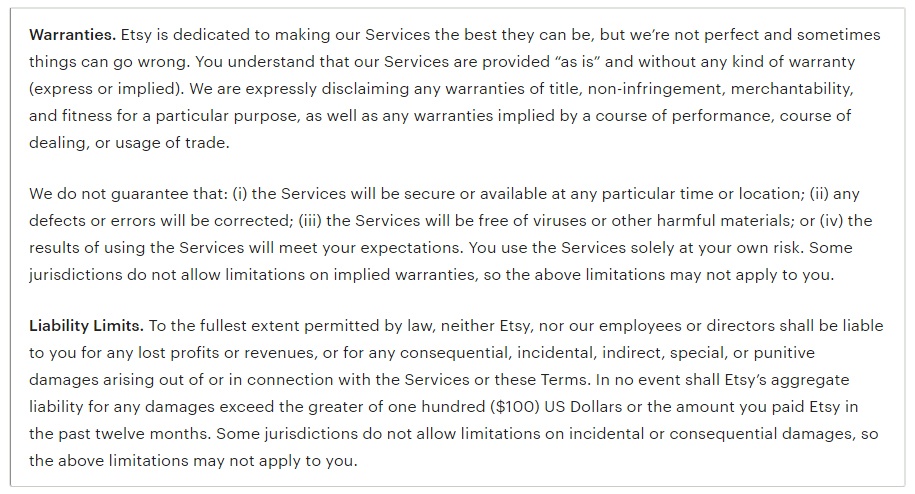
This clause establishes that the company provides its services “as is” and will not be held legally liable for damages from shopping with Etsy.
2. Intellectual Property/Trademarks
As the owner of an ecommerce store, you likely have unique items, designs, content or other proprietary rights that you want to protect. You can do this with a properly written clause dedicated to establishing your Intellectual Property Rights.
The Terms and Conditions agreement gives you a platform to declare what falls under your intellectual property, what the rules are for using those items or information, and what happens if an individual violates your intellectual property rights.
Let’s look at this example from the Intellectual Property, Software and Content clause of the ASOS Terms and Conditions. This clause states that the software and content available through the website belongs to ASOS or its licensors and is protected by copyright laws. It goes on to explain what customers can and cannot do with the content or software.
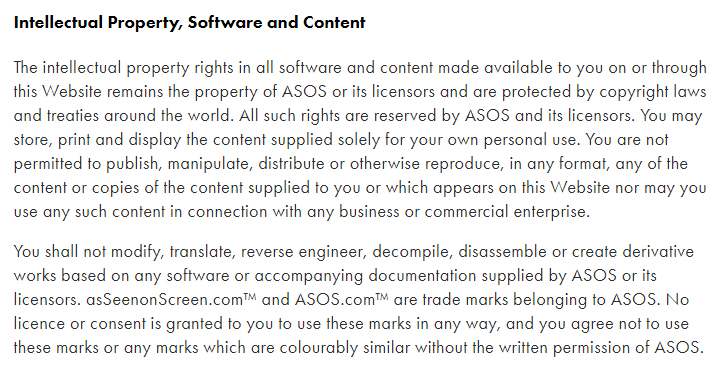
You should create a similar clause within your Terms and Conditions in order to protect your proprietary products and information. Website content, product descriptions, sales emails, coupon codes, designs and other things unique to your business should be covered by an Intellectual Property clause in order to protect your investments in your ecommerce store.
3. Pricing and Payment Terms
Product prices are almost always subject to change, and your right to make these changes should be established in a dedicated Pricing or Payments clause. Other details of customer transactions, such as shipping, returns, refunds and discounts also should be addressed in this clause in order to give you the legal rights to manage these matters in the interest of your online store.
For example, the Terms and Conditions page on the Manolo Blahnik website includes a Price and Payment clause that explains that prices of the products listed on the site and their delivery costs may be changed at any time. It also establishes that the ecommerce store only accepts payments made through credit or debit cards on the checkout page.
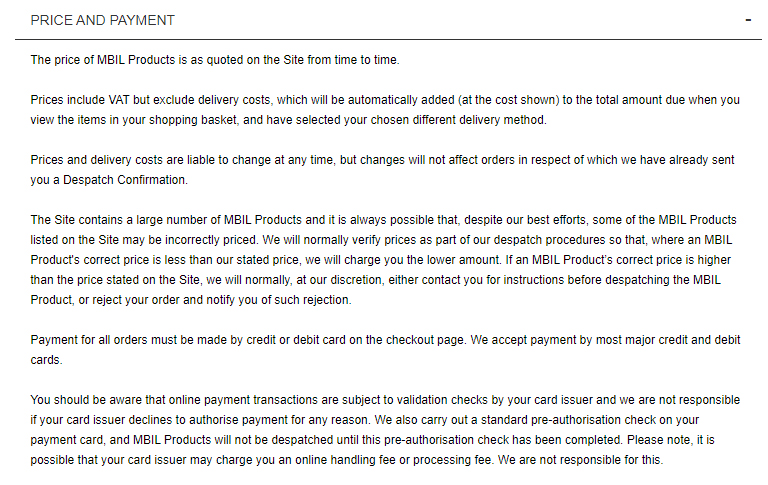
Because you have certain requirements for processing payments, shipping products and managing returns, and because certain things are out of your control (such as shipping delays), you should include a Price and Payments clause in your Terms and Conditions.
4. Dispute Resolution
The Dispute Resolution clause is important for ecommerce stores because it defines the procedures that will be followed in the event of a dispute. This clause typically establishes the jurisdiction where any disputes will be arbitrated if it comes to that, and the governing law that will apply. Obviously, these decisions should be made in the interest of the store’s owner.
This clause is particularly important for ecommerce stores that cater to a global audience. Different countries have different laws which could impact the outcome of any dispute.
Apple’s Terms of Use includes a clause for Governing Law: Dispute Resolution. It establishes that the laws of the United States and the State of California will be the governing laws in the event of any dispute. It makes an exception, however, for disputes arising from the European Union, in which case, a claim may be made in the country where the complainant resides.
In addition to this, it also mentions that you must make your claims within a timeframe of one year. Finally, it gives some information on how the dispute will be handled if it’s not resolved within a reasonable time.
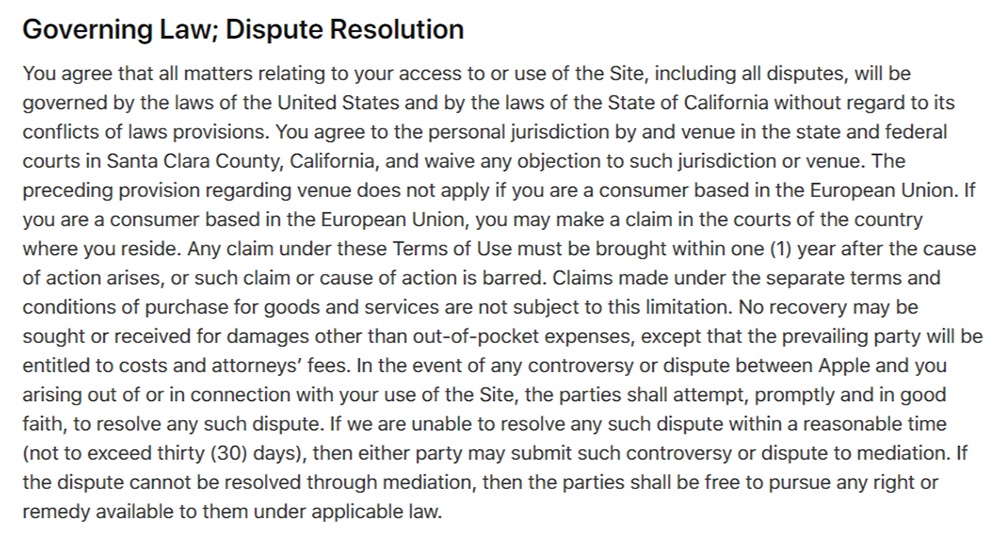
Apple’s Governing Law; Dispute Resolution clause offers a good guide for how to establish your Governing Law clause. While it’s clear that Apple serves a global audience, it might not be so clear in your case if you target a narrower audience.
Because the Internet is a global marketplace, it is a good idea to consider the possibility that your online customers may come from countries outside of your home country, and write this clause with that in mind.
Displaying Your Terms and Conditions

How you display your Terms and Conditions is another important consideration.
Typically, online stores will include a link to their Terms and Conditions somewhere in the homepage footer, and often near other important links, such as a link to a Privacy Policy.

Other stores also will include a link to their Terms and Conditions on the checkout page, above the Submit or Checkout button.

As important as where you display your Terms and Conditions agreement is how you present it. Changing laws designed to protect consumers online make it necessary for you to consider extra precautions in ensuring your customers understand and accept your Terms.
As mentioned earlier, there are two methods for establishing that your customers accept your Terms. The traditional way is passive, in which by virtue of posting your Terms on your site and your customers voluntarily using your site, you assume they accept your Terms. This method is called browsewrap, which means the customer is not required to click or take any other action to establish their consent to your Terms.
The newer — and better — way to acquire your customers’ consent to your Terms is to require them to click a box or a button to actively confirm their consent. This method is called clickwrap. It is the preferred method for ensuring your customers are aware of your Terms, and that they consent to those Terms and is quickly becoming the only legally compliant way to get consent.
Here’s a simple example of an effective use of clickwrap from Apex Solutions. It uses an unchecked accept box for acquiring a customer’s active and confirmed consent to the site’s Terms before the customer is permitted to purchase the company’s software products.
 You can present your Terms with a clickwrap agreement wherever you provide website registration, account sign-up, shopping cart checkout, etc.
You can present your Terms with a clickwrap agreement wherever you provide website registration, account sign-up, shopping cart checkout, etc.
Bluehost, which uses a clickwrap approach to acquire confirmed consent to the site’s Terms.

The Bluehost customer must tick the checkbox to confirm their agreement with the site’s Terms before they can complete a purchase.
In addition to presenting a clickwrap agreement with your Terms and Conditions, you want to display a link to your Terms in a conspicuous location, such as in the footer in the example above. This is for the benefit of your customers so they can click to read your Terms at any time without the frustration of trying to locate them.
To best protect your ecommerce store’s intellectual property and limit your legal liabilities, you will want to use a clickwrap method to acquire your customers’ confirmed consent to your Terms.
Next Steps
To get started on creating a solid Terms and Conditions agreement for your ecommerce store, consider the following:
- What intellectual property do you want to protect
- What liabilities do you want to avoid, such as product malfunctions or website problems
- Where do your customers live
- What jurisdiction(s) do you want to establish to arbitrate any disputes
- What products or services are out of your control, such as shipping, third party creative work, payments processing, weather or acts of God, etc.
- Where do you want to ensure your customers see, understand and accept your Terms
- Are you getting active consent to your Terms with a clickwrap agreement
Once you make these decisions, you will be prepared to make any necessary updates to your website or checkout page and write a comprehensive Terms and Conditions that protects your ecommerce store and your rights.

